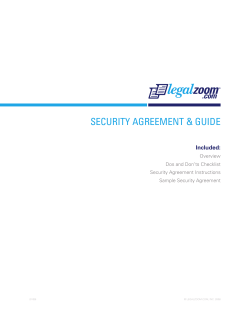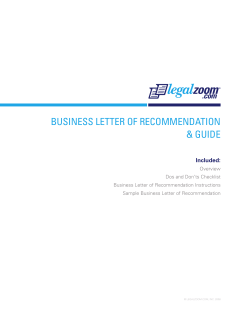
GENERAL CONTRACT AGREEMENT & GUIDE Included: Overview
GENERAL CONTRACT AGREEMENT & GUIDE Included: Overview Dos and Don’ts Checklist General Agreement Instructions Model General Agreement © LEGALZOOM.COM, INC. 2008 1. Overview Every agreement has terms and conditions that should be understood by every party that signs it. However simple your agreement seems, it is important to set forth its terms set writing. With the enclosed general agreement, you can protect yourself and the other parties, clarify conditions, and ensure a clear and correct understanding of the terms. Never underestimate the power of the written word: it can ensure satisfaction and protect all parties in the event of a breach. This package contains contract essentials, providing a standard form agreement that should prove useful to your business. It does more than ensure that both parties are confirm their promises in writing—it also establishes expectations, confirms the binding nature of the agreement, and provides measures for enforcement. In the consideration, discussion, and statement of a written agreement, the parties can go a long way toward promoting a successful partnership, deal, or business relationship. A written contract minimizes confusion, misunderstandings, and errors, and clearly sets forth expectations and fulfillment obligations. In every way, this promotes a successful and profitable arrangement. 2. Dos & Don’ts Checklist Preparing a written contract is the first of many steps in protecting your business and promoting longlasting business relationships. The following tips will provide additional guidance about protecting your company: Before writing your agreement, decide what your goals are for the contract. A good legal contract is one that captures the intentions of the parties accurately. Take a moment to clarify the terms and conditions of the agreement before memorializing them in written form. Allow each party ample time to review and sign the agreement, preferably a few days. This will reduce the likelihood, or at least the efficacy, of a claim that a party did not understand the agreement’s terms. Anticipate and be ready to answer questions about the document. A contract should be signed before any services are performed, goods are exchanged, or money is transferred. Sign two copies of the agreement, one for you and one for the other party to the agreement. Maintaining accurate records is essential for your company’s long-term success. All important documents should be kept in an organized and accessible file. Depending on the nature of its terms, you may decide to have your agreement witnessed or notarized. This will limit later challenges to the validity of a party’s signature. GENERAL CONTRACT AGREEMENT & GUIDE © LEGALZOOM.COM, INC. 2008 1 Because this is a general agreement, both parties should review the agreement carefully to ensure that all relevant deal points have been included. It is better to be over-inclusive than underinclusive. Do not assume that certain expectations or terms are agreed to if they are not stated expressly on the document. If your deal or agreement is complicated, do not use this agreement. Contact an attorney to help you draft a contract that will meet your specific needs. At all times, you and your representatives should conduct yourselves in a professional, courteous, lawful, and non-discriminatory manner. 3. General Agreement Instructions The following provision-by-provision instructions will help you understand the terms of your general agreement. The numbers and letters below (e.g., Section 1(a), Section 2(d), etc.) correspond to the provisions in the agreement. Please review the entire agreement in its entirety before starting the step-by-step process. • Introduction of Parties. Identifies the parties and the date of the agreement. Each party is given a name (e.g., “Party One”) that will be used throughout the agreement. • Section 1: Party One Obligations. In most agreements, each party to the agreement is expect to do something. This obligation may be to perform a service, transfer ownership of property, or pay money. There is a blank space in which you should describe the obligations of the first party to the agreement. Specific and clear language makes an agreement stronger, so take your time in drafting this. Will specific materials be used? Is there a time limit? Include any information you think is important. • Section 2: Party Two Obligations. Describe the obligations of the second party to the agreement. As above, take your time and make the language specific and clear. • Section 3: Representations and Warranties of the Parties. This is an optional provision that the parties can use to list additional promises, understandings, and assumptions. For example, if one party is selling an item, that party can promise that the item meets certain quality standards. If one party is performing a service, that party may swear that he is fully licensed and insured. If you remove this section, correct the section numbers in the agreement • Section 4: Additional Terms. This is an optional provision that can include any additional terms that have not already been listed. For example, if the parties will exchange confidential information is, you may want to include a provision governing the protection of that information. If you remove this section, correct the section numbers in the agreement GENERAL CONTRACT AGREEMENT & GUIDE © LEGALZOOM.COM, INC. 2008 2 • Section 5: Arbitration. This is an optional provision. With the rising cost of litigation (in both time and resources), arbitration provisions have become common contractual terms. These provide that in the event of a dispute, the parties will participate in binding arbitration rather than court litigation. In binding arbitration, the parties agree to be bound by the decision of a neutral third party. This is preferred by many business people as a faster and less expensive alternative to traditional litigation. Review your state’s laws to ensure that the agreement complies with its arbitration provisions. If you remove this section, correct the section numbers in the agreement • Section 6: General Provisions. The following subsections contain universal contract language. Although the terms sound technical, they are general provisions with simple objectives. • Section 6(A): Notices. Lists the addresses to which all official or legal correspondence will be delivered. • Section 6(B): Successors and Assigns. States that neither party can transfer its obligations under the agreement without the prior written consent of the other party. • Section 6(C): Waiver and Amendment. Explains that neither party can ignore or dismiss any part of the agreement, and that any changes to the agreement will be in writing and signed by both parties. • Section 6(D): Entire Agreement. The parties’ agreement that the document they’re signing is “the agreement” about the issues involved. In other words, if previous agreements or promises surface, the signed agreement will control. Unfortunately, the inclusion of this provision will not prevent a party from arguing that other enforceable promises exist, but it will provide you some protection from these claims. • Section 6(E): Severability. Protects the terms of the agreement as a whole, even if one part is later invalidated. For example, if a state law is passed prohibiting arbitration clauses, it will not undo the entire agreement. Instead, only the section dealing with arbitration would be invalidated, leaving the remainder of the agreement enforceable. • Section 6(F): Governing Law. A governing law provision allows the parties to choose the state laws that will be used to interpret the agreement. Note that this is not a venue provision: the included language will not impact where a potential claim can be brought. Please write the applicable state in the blank provided. • Section 6(G): Voluntary Execution of the Agreement. Indicates that all of the parties have had time to review and understand the agreement, and have had sufficient opportunity to obtain legal representation (if desired). • Section 6(H): Counterparts/Electronic Signatures. The title of this provision sounds complicated, but it is simple to explain: it says that even if the parties sign the agreement in different locations, or use electronic devices to transmit signatures (e.g., fax machines or computers), all of the separate pieces will be considered part of the same agreement. In a modern world where signing parties are often not in the same city - much less the same room - this provision ensures that business can be transacted efficiently, without sacrificing the validity of the agreement as a whole. GENERAL CONTRACT AGREEMENT & GUIDE © LEGALZOOM.COM, INC. 2008 3 As you create an agreement that meets your specific needs, keep your goals in mind: a well-written document should enhance the parties’ understanding of their deal and not obscure it. If any provision of your agreement is confusing, try to make it clearer. A few hours spent improving your agreement now could prevent weeks of future headaches. The enclosed document can help achieve a clear and mutual understanding of the terms of your agreement, and can set realistic expectations for both parties. If you follow the suggestions provided, potential conflicts can be minimized. Moreover, if a dispute does arise, you will be well on your way to defending your company successfully and providing the documentation needed to protect your business. Congratulations! DISCLAIMER LegalZoom is not a law firm. The information contained in the packet is general legal information and should not be construed as legal advice to be applied to any specific factual situation. The use of the materials in this packet does not create or constitute an attorney-client relationship between the user of this form and LegalZoom, its employees or any other person associated with LegalZoom. Because the law differs in each legal jurisdiction and may be interpreted or applied differently depending on your location or situation, you should not rely upon the materials provided in this packet without first consulting an attorney with respect to your specific situation. The materials in this packet are provided "As-Is," without warranty or condition of any kind whatsoever. LegalZoom does not warrant the materials' quality, accuracy, timeliness, completeness, merchantability or fitness for use or purpose. To the maximum extent provided by law, LegalZoom, it agents and officers shall not be liable for any damages whatsoever (including compensatory, special, direct, incidental, indirect, consequential, punitive or any other damages) arising out of the use or the inability to use the materials provided in this packet. GENERAL CONTRACT AGREEMENT & GUIDE © LEGALZOOM.COM, INC. 2008 4 Form Sample GENERAL CONTRACT AGREEMENT & GUIDE © LEGALZOOM.COM, INC. 2008 5
© Copyright 2025





















